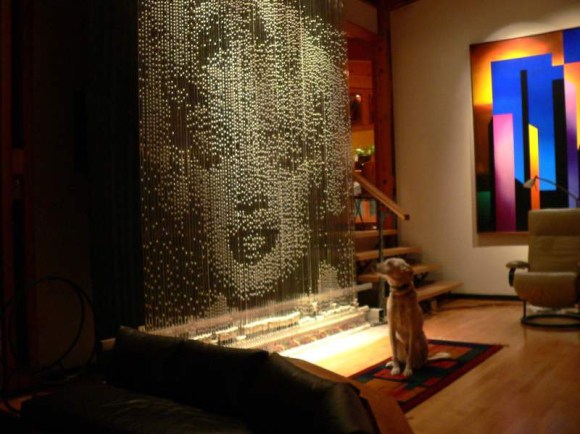
[Bruce] has created a pretty cool bubble display that is capable of showing recognizable photographs of people. This entire art installation is no slouch at 3-stories tall! This one resides at the Ontario Science Centre in Toronto, Canada. If you are unfamiliar with bubble displays, they consist of several clear vertical tubes filled with a liquid. A pneumatic solenoid valve mounted at the bottom of each tube allows a controlled amount of air to enter the tube at a very specific time. Since the air weighs less than the liquid, the air bubble travels up the tube of liquid. Interesting patterns can be made if these bubbles are timed correctly. This setup uses a Linux-based computer with custom control software to manipulate the valves.
[Bruce] didn’t start off making super-complex bubble displays. This is actually his 3rd go-around and with 96 individual tubes and capable of displaying raster images, it is the most complicated so far. His first creation consisted of 16 tubes, each larger in diameter than the most recent creation. With the larger diameter and less number of tubes came less resolution and the ability to only display simple shapes. Version 2 had twice as many tubes, 32 this time. In addition to doubling the tube quantity [Bruce] also colored the fluid in the tubes, not all the same color but all the colors of the rainbow, from red to violet. Still, this version could not show raster images. It appears to us that the third time’s the charm! Video after the break….

If you’re interested in more DIY-friendly bubble displays, check out this 60-tube build with RGB’s or this 3 dimensional bubble display.















Ah, I’ve seen his original one at the MN Science museum. I didn’t realize they had mineral oil in them, I remembered the bubbles moving much faster. Now that makes me want to try something similar in the style of those old ‘rain’ lanterns with the mineral oil dripping down nylon strings..
Now that’s a bubble display! Not tiny lensed seven segment displays. Do it in a fish tank. Tubes would nearly disappear under water.
Very clever and a great look.
Is that a meerkat watching?
The dog totally makes the picture. It’s like he has a crush on Marilyn.
Wow, done in 2006. I wonder if it’s still running?
Good idea above; the tubes actually would seem to disappear submersed in water!
I wonder if the majority of the light comes from the walls of the cylinders or if it comes from the top and/or bottom. If most of the light comes from the walls, then one could implement some sort of nozzle that could proportionally mix CYMKW gasses so the images could reproduce the full color spectrum!
I wonder if you made a 2D grid of these tubes what would that look like.
Of course rendering 3D images with Marilyn Monroe or Albert Einstein becomes a bit harder because there are no 3D scans of them (yet). I’m trying to picture how you could easily generate static 3D models of them from the archived 2D video that exist of them.
http://www.turbosquid.com/3d-models/decorative-bust-albert-einstein-3d-max/617116
this is the internet, all you need to do is find somebody who already did the work for you!
But that used a human to see images of the man and create it in modelling clay and then it was scanned. I was thinking more along the lines of some image processing that took the human interpretation out of the equation a bit more, if you know what I mean.
Very nice!
While watching this I stumbles upon this guy: https://www.youtube.com/user/summetj/videos
He has a lot of background info videos on his bubble display. Also check his other hacks!
You can look at a lot of photographs of the installation at the Ontario Science Centre here:
http://bobodyne.com/web-docs/robots/OSC/
It was quite a process as you can see.
Saw this with my Kids last month.. they had a blast playing around with it.. It really does a good job at rastering high contrast pictures for display..
Just in case anyone doesn’t make the connection – Bruce Shapiro (zis guy) is the guy behind the original Egg-Bot machine as well. Has some extremely cool motion-control artworks on his site.
Thanks for the kind words. This is the prototype and proof of concept for the one Alan Kilian helped me install 8 years ago in Toronto. It’s definitely still running. The most recent (2010) was installed in Warsaw, at the (then) new Copernicus Science Centre.
And that’s my beloved (now gone) Ajax, looking at marilyn.